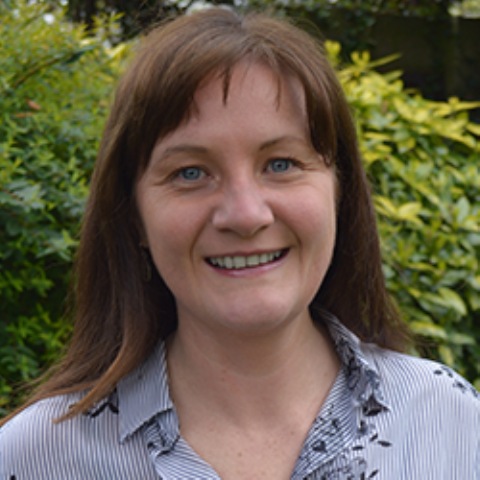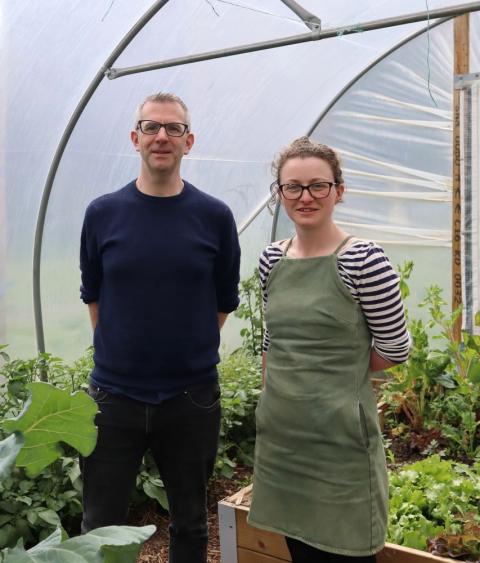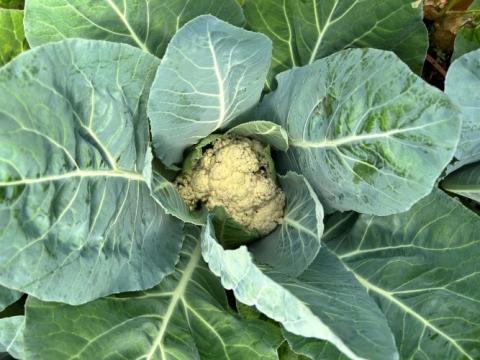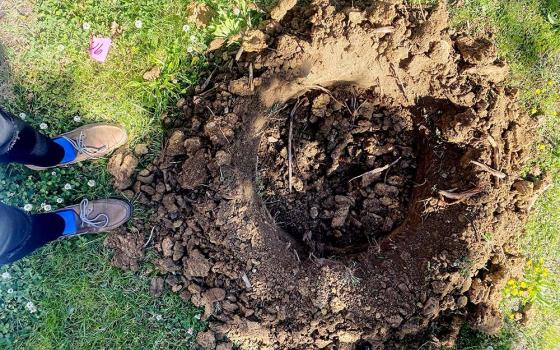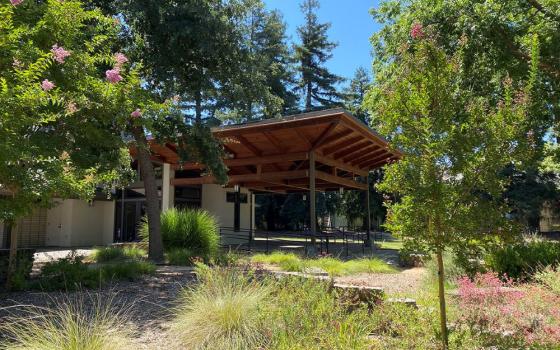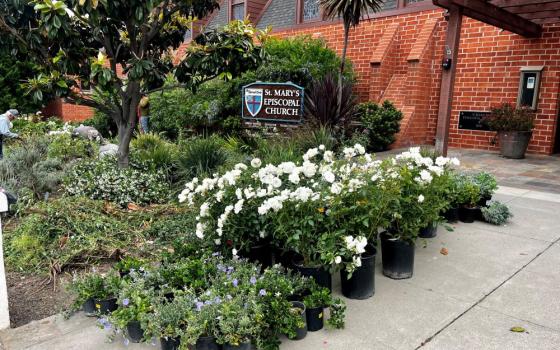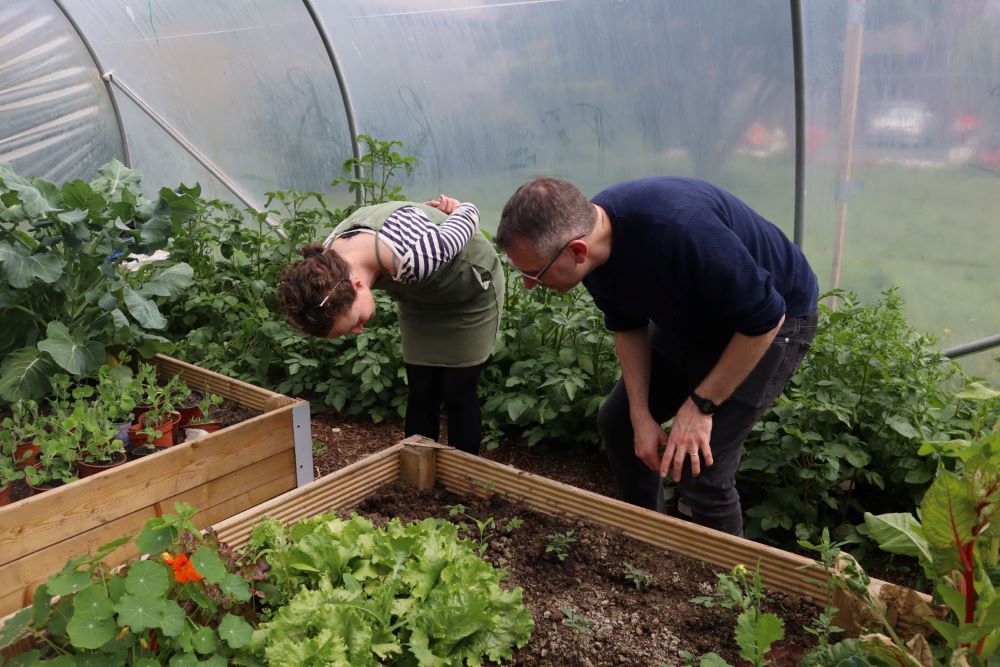
Kevin Hargaden, theologian (right), and Ciara Murphy, environmental biologist, authors of The Parish as Oasis: An Introduction to Practical Environmental Care, are seen in the polytunnel in the garden behind Gardiner Street Parish in Dublin. Their book is a resource for parishes responding to Irish bishops' request that parishes conserve 30% of their property for pollinators and biodiversity. (Courtesy of Jesuit Centre for Faith and Justice)
Editor's note: This story is part of "Growing a Green Church," an ongoing series focused on churches' efforts to steward their buildings and land effectively in the context of a changing climate. The project is produced in collaboration with The Christian Century, Episcopal News Service, Faithfully Magazine, National Catholic Reporter and Sojourners, with support from the Solutions Journalism Network and funding from the Fetzer Institute. Find more stories in the series here.
Irish bishops have asked parishes across Ireland to set aside 30% of their grounds for pollinators and biodiversity by 2030 so the land can be enjoyed "in perpetuity by the whole community."
With 1,365 parishes that include 2,646 churches across 26 dioceses on the island of Ireland, the initiative has the potential to make a difference to local biodiversity as well as create awareness of global conservation efforts, particularly the agreement of countries at the 2022 United Nations conference on biological diversity, COP15, to return 30% of land to nature. It also strives to increase awareness of church teaching on ecology and highlight the role of people of faith in protecting creation.
The bishops made the call to conserve nearly a third of church property after their spring and summer meetings in Maynooth, County Kildare, in March and June. The bishops explained that as a first step, parishes through their pastoral councils and diocesan trusts should map their church grounds to identify the 30% that will become a haven for pollinators and biodiversity. The initiative is a response to Pope Francis' 2015 encyclical, "Laudato Si', on Care for Our Common Home," the impending loss of biodiversity and agreements made at COP15 in Montreal in December 2022.
The move has been hailed by Jane Mellett, Laudato Si' officer with the bishops' development agency, Trócaire, who told EarthBeat it was, "Great to see this leadership in response to the biodiversity crisis." She said that the National Biodiversity Data Centre in Ireland has welcomed the bishops' proposal and would be happy to journey with a pilot parish.
Mellett noted that the Irish Catholic Bishops' Conference was the first bishops' conference in the world to divest their assets from fossil fuels. Since then, the bishops' conferences in Austria, Belgium, Eastern Africa, the Philippines and Scotland have also pledged to divest, according to data compiled by the Laudato Si' Movement.
Bishop Martin Hayes, the coordinating bishop for Laudato Si' in the Irish church, told EarthBeat that the biodiversity and pollinators proposal is "a strong recommendation," not a requirement. Every parish "will be encouraged to identify parishioners with a passion for gardening as well as local expertise in gardening to initially map the areas that could nurture the cultivation of wildflowers essential to pollinators."
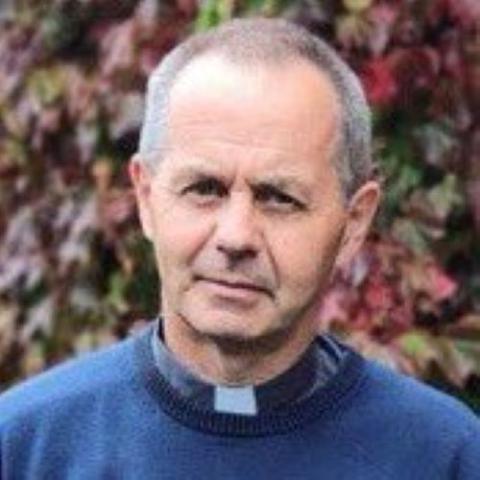
Bishop Martin Hayes of Kilmore Diocese is the coordinating bishop for Laudato Si' in the Irish church. (Courtesy of Catholic Communications Office, Maynooth, County Kildare)
He acknowledged that some parishes will need support to see this initiative as part of their Christian commitment and to recognize the importance of caring for our common home as expressed by Francis in Laudato Si'.
Hayes, who leads Kilmore Diocese, explained that the Laudato Si' Working Group, or LSWG, affiliated with the Irish Episcopal Conference's Council for Education is developing resources to implement this recommendation. These will include The Faith Community Pollinator Plan and Gardening for Biodiversity.
As a member of the LSWG, which advises the Irish bishops, Mellett said the bishops' proposal originated with this 12-member group, which includes climate experts, theologians with a focus on ecology and those working on the ground, like Mellett, who can draw on the experiences of Trócaire's staff in places around the world worst affected by the climate crisis.
"In our work overseas, Trócaire has a whole area of work in agro-ecology where we work with local communities on food security. This is a huge issue because most of our countries are climate affected by drought and so advocating for climate justice is definitely a priority for us," Mellett said.
The LSWG is "constantly" asked for advice on concrete actions that people can take, she added. "We can't just keep talking about the problems. This recommendation from the bishops is solutions based, and it is timely."
The impetus for the LSWG's proposal to the bishops was a paper on why Christians should care about biodiversity loss by theologian Fr. Sean McDonagh, who is a member of the LSWG. "It was a response to the startling statistics in that paper and the agreement by countries attending COP15 to return 30% of land to nature and 30% of the oceans," Mellett said. "At one of our meetings, members of the LSWG asked what would it look like if we did this as a parish."
Autumn colors frame the Cathedral of Our Lady Assumed into Heaven and St. Nicholas, commonly known as the Galway Cathedral, in Ireland Oct. 20, 2020. (CNS/Reuters/Clodagh Kilcoyne)
Mellett believes the timeframe of 2030 is "sufficient to do something very worthwhile." Though most parishes will be starting from scratch, they hope to begin to see results within two or three years. It also ties in with the Vatican's Laudato Si' Action Platform, a multiyear, global effort which has set a deadline of 2030 for implementing concrete actions on sustainability.
Mellett stressed that the bishops' proposal shouldn't be another task for the parish priest. "We understand the pressures that parish teams are under," she said. "It should be an initiative of the parish council with individuals on the ground making it happen."
She believes that some of the 700 people who have done a six-week Laudato Si' course since March 2020, which she facilitates, will be drivers within parishes. "A network has been established and there has been theological and spiritual education at the grassroots," she said. "It is likely that care for creation groups in parishes or those who have attended these Laudato Si' courses through Trócaire or the Laudato Si' Movement will spearhead the re-wilding project in parishes."
Mellett stressed that the project focuses on church grounds. "We are encouraging parish councils to engage local expertise by reaching out to groups in the community like allotment groups or whoever has a bit of knowledge around biodiversity, gardens and horticulture," she said. "We don't have to reinvent the wheel."
But parishes need to be very clear about why they are doing this. "It is a chance for catechesis on Laudato Si'," she said.
One parish already re-wilding for pollinators is Killlorglin in County Kerry, which Mellett says has a wonderful biodiversity garden. "They cleared some ground around the church and they have created a garden that's flourishing between pollinating, vegetable growing and tree planting," she said. "They have a small team of just four people who manage it once a week."
A parish in Shankill, County Dublin, recently won a gold star designation as an eco parish from Eco Congregation Ireland, an ecumenical group that provides practical planning for re-wilding for pollinators and care for the earth. The group provides "a very clear list of tasks in order to achieve a bronze, silver or a gold award," Mellett said.
"In Shankill they have done simple things like letting meadows form, and they have replanted the edges of the lawn with pollinating plants. They have done great work on energy in the parish as well. These small things make a difference over time."
Rural parishes may more easily be able to dedicate 30% of their church grounds to pollinators and biodiversity than urban parishes. "Someone did ask me were we expecting them to tear up car parks! That is not what we are asking," Mellett said. "We are asking parishes to map the space they have and take 30% of that space and work with it. It might be tiny. You could use potted plants in sections of the car park and stop spraying the car park."
She also advises parishes to consult the National Pollinator Plan, which she describes as "a superb resource" with a section for faith communities.
The bishops' recommendation has been "warmly welcomed" by the parish pastoral council of Balally Parish in South Dublin. A subcommittee, Balally Environmental Group, was founded in 2009. The parish is beginning to think about drawing up a plan to implement the proposal.
"At present, Balally Parish is in dialogue with a neighboring parish to explore the possibility of a joint approach to putting aside 30% of church grounds," said Fr. Jim Caffrey, parish priest. He added that they are also waiting for guidelines for parishes to be issued.
A flock of geese fly past the Poolbeg Generating Station chimney stacks at sunset in Dublin Feb. 21, 2021. The Irish Catholic Bishops' Conference was the first bishops' conference in the world to divest their assets from fossil fuels. (CNS/Reuters/Clodagh Kilcoyne)
One resource for parishes is The Parish as Oasis: An Introduction to Practical Environmental Care by Kevin Hargaden, a theologian, and Ciara Murphy, an environmental biologist. Both work for the Jesuit Centre for Faith and Justice, which is based in Gardiner Street, an urban parish in Dublin. "We felt there was a lot of grassroots energy and action but what was missing was some kind of top-down pressure," Murphy told EarthBeat.
Seeing the church making such confident and ambitious proposals "energizes" people," Hargaden said. The proposal is "an invitation for increased lay participation and real lay leadership because it is the parish councils who are going to implement this. It is an opportunity to care for the environment, build community and to do discipleship and engage in mission."
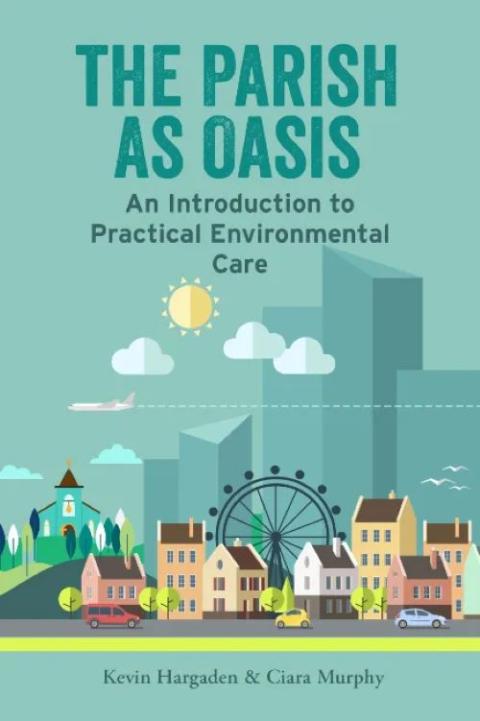
"The Parish as Oasis: An Introduction to Practical Environmental Care" by Kevin Hargaden and Ciara Murphy was published in 2022 by Messenger Publications.
A vision for the church, Hargaden believes, lies in Clane, County Kildare, where four denominations — Catholic, Church of Ireland, Presbyterian and Christian Fellowship — are working together in their care for the earth. "As Christians, we should take advantage of these ecumenical opportunities. Digging in the soil and working hard together is a great place to explore what it means to be Christians together and our creational call in Genesis as stewards of the earth."
The Jesuit parish on Dublin's Gardiner Street has a substantial walled garden behind the church and its ancillary Georgian buildings housing the community and offices. The church faces the busy city street with no green space, but the garden is a haven of biodiversity. Taking the lead from Adam and Eve as gardeners, a theme explored in their book, both Murphy and Hargaden have worked with the Jesuits to make this space as green and biodiverse as possible.
The space has become an oasis for children attending the neighboring primary school. During the COVID-19 pandemic, classes were allowed into the garden at break time. Teachers told Murphy that they could tell which students had been in the garden and which had remained in the school's concrete yard. "Their behavior and attitude was different," she said. "They were better able to learn, because if they fell, they didn't hurt themselves. And there were more things to look at, and there was less stress."
Advertisement
The Jesuits have since built a polytunnel, a plastic-covered structure similar to a greenhouse, as "an outdoor classroom" for the schoolchildren. One class is growing vegetables.
Murphy said Gardiner Street is trying to figure out how to do even more with the garden to increase the biodiversity in the lawn and attract more insects and birds. "We are looking at how we make rain gardens from the gutters and making sure that this doesn't impact the infrastructure," because the church and its Georgian buildings are protected structures. They also are discussing the possibility of geothermal heating and some retrofitting.
Tying the sacramental life of a parish to environmental care is an important motif for Hargaden. He is inspired by Clane Parish in County Kildare, where every child baptized in the parish for the last 10 years, and every couple that has married, have been gifted a native Irish tree. "Over 1,300 trees have been planted in Clane as a result of the sacramental life of the church," he said. "If we had a tapestry of parishes across Ireland engaged in that kind meaningful witnessing, it would be a profoundly rich symbol.

